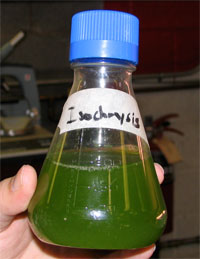Where There's Algae, There's Promise for Petroleum Alternative
NewsJackson Adolph and Mike DePaola are looking forward to a future full of green—algae, that is.
The two integrated science and technology majors have been working since last spring researching the most efficient and economical ways to grow and harvest the oil-rich plant, which shows promise in reducing America's dependence on petroleum.
With Exxon Mobil sinking $600 million into algae-based biofuels in 2009 and the U.S. Navy consistently increasing its use of algae-based fuels, there's reason to be excited about its future.
"No doubt this is what I want to do," Adolph said. "You always have to be optimistic. We've learned a ton about how to do this."
Adolph and DePaola had a chance to discuss what they've learned so far during the first Valley 25x'25 Fall Research Review on Oct. 10. Valley 25x'25 is based at JMU and promotes using a diverse energy portfolio to achieve 25 percent renewable energy in the Shenandoah Valley before 2025. The organization provided funding for the algae fuel research and to 10 other projects presented at the research review.
The algae research is a reincarnation of research from several years ago. Dr. Chris Bachmann, associate professor of integrated science and technology, said lack of funding was among the reasons for mothballing the project until now.
"Without funding, it’s tough to keep moving forward. At that point, it was better for the students to pursue projects elsewhere," he said.
But times have changed and Exxon Mobil and the Navy are not the only big players in algae fuel research. NASA also is busy with the Offshore Membrane Enclosure for Growing Algae (OMEGA) project, which involves growing algae in semi-permeable membranes in the ocean where it does not compete for space with land-based agriculture. That's the direction Adolph and DePaola are heading, growing their algae in dialysis tubing that lets nutrients in while keeping the algae contained. Among the goals is developing a process that will require less energy to remove the algae from the water than the amount of energy produced from the harvest.
So far, the two seniors have been experimenting with two saltwater algae species and one freshwater species, growing them in vials in a laboratory. If the weather cooperates in the spring, they plan to move some of the growing operation outdoors. They also have experimented with ways to separate the algae from the water. One idea they tested this summer was spraying a fine mist of algae water onto a sheet of metal heated by the sun. The water evaporated almost immediately, Adolph said, and they were able to scrape the algae off.
“Dried algae can be pressed and the fat is taken out which can be refined to oil. We hand it over to the biodiesel team to take care of that in the lab in ISAT,” said Adolph.

The team is also experimenting with chicken litter as a low-cost nutrient source for growing algae. Bachmann noted that Valley farmers are often accused of polluting the Chesapeake Bay by spreading poultry litter on their farm fields. The nitrogen from the litter seeps into the groundwater and allegedly flows to the Bay where it feeds unwanted algae blooms. If that claim is true, Bachmann said, then there is no reason why chicken litter can't be used to grow algae in the laboratory. And if it doesn't work in the laboratory, then maybe it's not as big a problem as it is purported to be.
Adolph and DePaoloa will give another report on the project at the ISAT senior symposium in April. The project is expected to continue next year with Caleb Talbot, a junior from Elkton, moving it forward.
|
|
Oil can be pressed from the dried algae to make "green crude." |



